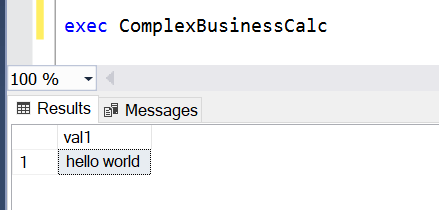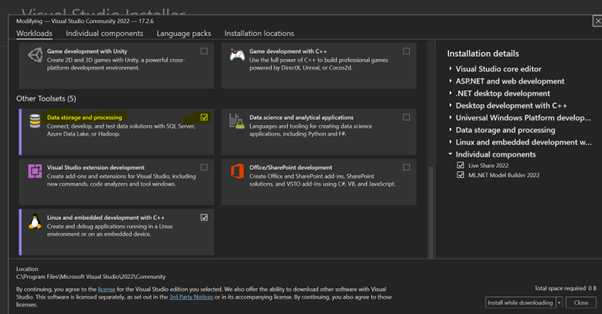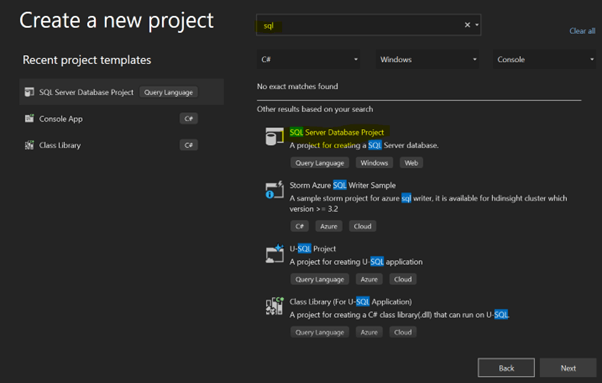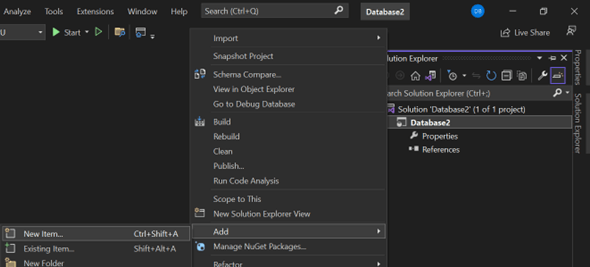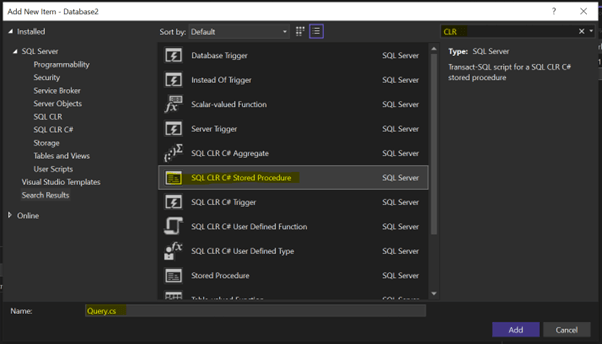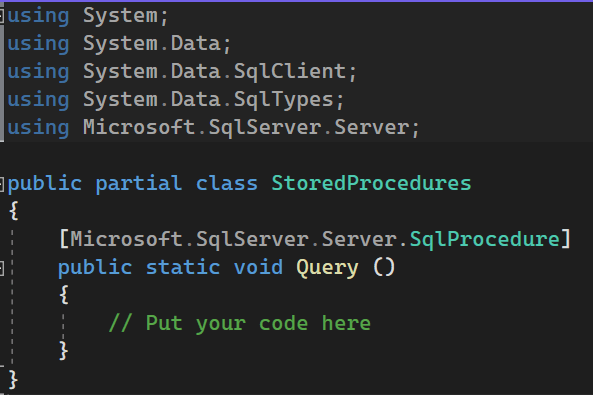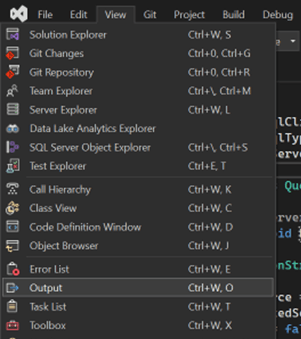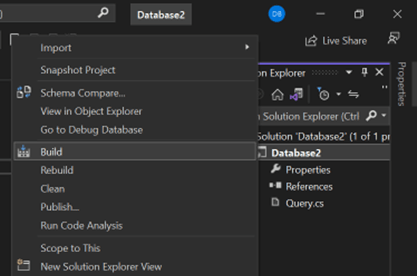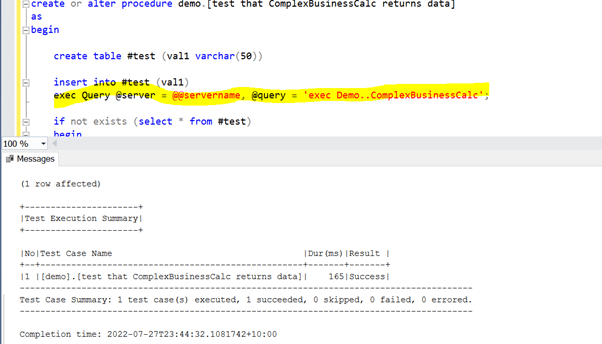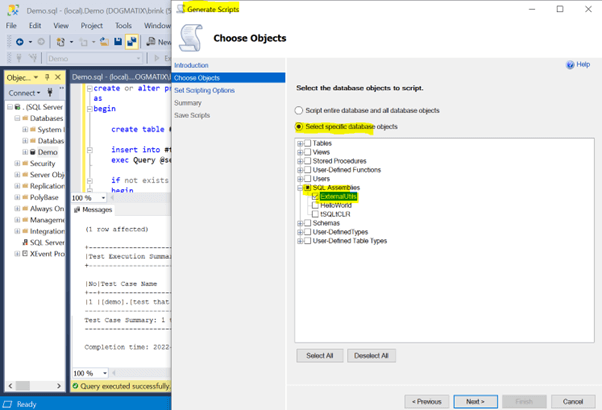18. сентября 2011 00:09

Но, что делать, если нам все-таки необходимо вывести результат работы процедуры в таблицу? Именно тому, как обойти одно из ограничений сиквела и посвящён этот пост.
Для иллюстрации создадим тестовую БД TestDB и две процедуры, одна будет возвращать небольшой рекордсет, а во второй мы будем вызывать эту процедуру с использованием инструкции INSERT EXEC.
create database TestDB go use TestDB go if object_id ( 'dbo.TestProc01', 'P' ) is not null drop procedure dbo.TestProc01 go create procedure dbo.TestProc01 as set nocount on declare @t table ( i int ) insert into @t values (1),(2),(3) select * from @t go if object_id ( 'dbo.TestProc02', 'P' ) is not null drop procedure dbo.TestProc02 go create procedure dbo.TestProc02 as set nocount on declare @t table ( i int ) insert into @t exec dbo.TestProc01 select * from @t go
Дальше небольшой скрипт, который и эмулирует, озвученную выше, ошибку:
declare @t table ( i int ) insert into @t exec dbo.TestProc02
А теперь несколько способов обойти эту ошибку:
1) Первый и самый правильный
По возможности не использовать вложенных инструкций INSERT EXEC, либо вместо вызова процедуры, в которой уже используется такая конструкция, взять часть скрипта из тела этой самой процедуры. Как правило, это достаточно легко можно реализовать. В моём примере достаточно заменить вызов процедуры dbo.TestProc02 на dbo.TestProc01.
2) Используем OPENQUERY или OPENROWSET
Для этого нам потребуется создать Linked Server с ссылкой нашего сервера БД на самого себя ( в моём случае это IP 127.0.0.1).
use master
go
exec sp_addlinkedserver N'127.0.0.1'
, N'SQL Server';
go
use TestDB
go
declare @t table ( i int )
insert into @t
select * from OpenQuery ( [127.0.0.1], 'TestDB.dbo.TestProc02' )
select * from @t
3) Используем распределённый запрос
declare @t table ( i int ) insert into @t exec [127.0.0.1].TestDB.dbo.TestProc02 select * from @t go --либо: declare @t table ( i int ) insert into @t exec ( 'TestDB.dbo.TestProc02' ) at [127.0.0.1] select * from @t go
Не забываем включить службу Координатор распределенных транзакций Иначе получим ошибку:
4) Используем процедуру xp_cmdshell и утилиту SQLCMD
Но для начала включим использование процедуры xp_cmdshell
exec sp_configure 'show advanced options', 1 reconfigure exec sp_configure 'xp_cmdshell', 1 reconfigure go
А теперь выгружаем результат работы процедуры dbo.TestProc02 в таблицу:
declare @t table ( val varchar(100) ) insert into @t exec master..xp_cmdshell 'sqlcmd -E -q "exec TestDB.dbo.TestProc02" -h -1 -W' select val from @t where val is not null
5) Используем процедуру xp_cmdshell и утилиту BCP
--Выгружаем результат процедуры dbo.TestProc02 на диск exec xp_cmdshell 'bcp "exec TestDB.dbo.TestProc02" queryout "c:tempTest.txt" -T -c -C RAW -rn -tchar(3)' --Создадим таблицу для получения результата if object_id ( 'dbo.tmpMyResult', 'U' ) is not null drop table tmpMyResult go create table tmpMyResult ( val int ) --Загружаем результат с диска в таблицу exec xp_cmdshell 'bcp TestDB.dbo.tmpMyResult in "c:tempTest.txt" -T -c -C RAW -rn -tchar(3)' --Смотрим select * from tmpMyResult
6) Используем CLR
Но этот вариант я не буду рассматривать в рамках этого поста.
I have three stored procedures Sp1, Sp2 and Sp3.
The first one (Sp1) will execute the second one (Sp2) and save returned data into @tempTB1 and the second one will execute the third one (Sp3) and save data into @tempTB2.
If I execute the Sp2 it will work and it will return me all my data from the Sp3, but the problem is in the Sp1, when I execute it it will display this error:
INSERT EXEC statement cannot be nested
I tried to change the place of execute Sp2 and it display me another error:
Cannot use the ROLLBACK statement
within an INSERT-EXEC statement.
SchmitzIT
9,1449 gold badges65 silver badges91 bronze badges
asked Sep 25, 2010 at 19:36
0
This is a common issue when attempting to ‘bubble’ up data from a chain of stored procedures. A restriction in SQL Server is you can only have one INSERT-EXEC active at a time. I recommend looking at How to Share Data Between Stored Procedures which is a very thorough article on patterns to work around this type of problem.
For example a work around could be to turn Sp3 into a Table-valued function.
answered Sep 25, 2010 at 20:18
Eddie GrovesEddie Groves
33.7k14 gold badges47 silver badges48 bronze badges
2
This is the only «simple» way to do this in SQL Server without some giant convoluted created function or executed sql string call, both of which are terrible solutions:
- create a temp table
- openrowset your stored procedure data into it
EXAMPLE:
INSERT INTO #YOUR_TEMP_TABLE
SELECT * FROM OPENROWSET ('SQLOLEDB','Server=(local);TRUSTED_CONNECTION=YES;','set fmtonly off EXEC [ServerName].dbo.[StoredProcedureName] 1,2,3')
Note: You MUST use ‘set fmtonly off’, AND you CANNOT add dynamic sql to this either inside the openrowset call, either for the string containing your stored procedure parameters or for the table name. Thats why you have to use a temp table rather than table variables, which would have been better, as it out performs temp table in most cases.
answered Jun 1, 2012 at 22:53
5
OK, encouraged by jimhark here is an example of the old single hash table approach: —
CREATE PROCEDURE SP3 as
BEGIN
SELECT 1, 'Data1'
UNION ALL
SELECT 2, 'Data2'
END
go
CREATE PROCEDURE SP2 as
BEGIN
if exists (select * from tempdb.dbo.sysobjects o where o.xtype in ('U') and o.id = object_id(N'tempdb..#tmp1'))
INSERT INTO #tmp1
EXEC SP3
else
EXEC SP3
END
go
CREATE PROCEDURE SP1 as
BEGIN
EXEC SP2
END
GO
/*
--I want some data back from SP3
-- Just run the SP1
EXEC SP1
*/
/*
--I want some data back from SP3 into a table to do something useful
--Try run this - get an error - can't nest Execs
if exists (select * from tempdb.dbo.sysobjects o where o.xtype in ('U') and o.id = object_id(N'tempdb..#tmp1'))
DROP TABLE #tmp1
CREATE TABLE #tmp1 (ID INT, Data VARCHAR(20))
INSERT INTO #tmp1
EXEC SP1
*/
/*
--I want some data back from SP3 into a table to do something useful
--However, if we run this single hash temp table it is in scope anyway so
--no need for the exec insert
if exists (select * from tempdb.dbo.sysobjects o where o.xtype in ('U') and o.id = object_id(N'tempdb..#tmp1'))
DROP TABLE #tmp1
CREATE TABLE #tmp1 (ID INT, Data VARCHAR(20))
EXEC SP1
SELECT * FROM #tmp1
*/
answered May 16, 2016 at 12:00
2
My work around for this problem has always been to use the principle that single hash temp tables are in scope to any called procs. So, I have an option switch in the proc parameters (default set to off). If this is switched on, the called proc will insert the results into the temp table created in the calling proc. I think in the past I have taken it a step further and put some code in the called proc to check if the single hash table exists in scope, if it does then insert the code, otherwise return the result set. Seems to work well — best way of passing large data sets between procs.
answered May 4, 2016 at 7:27
4
This trick works for me.
You don’t have this problem on remote server, because on remote server, the last insert command waits for the result of previous command to execute. It’s not the case on same server.
Profit that situation for a workaround.
If you have the right permission to create a Linked Server, do it.
Create the same server as linked server.
- in SSMS, log into your server
- go to «Server Object
- Right Click on «Linked Servers», then «New Linked Server»
- on the dialog, give any name of your linked server : eg: THISSERVER
- server type is «Other data source»
- Provider : Microsoft OLE DB Provider for SQL server
- Data source: your IP, it can be also just a dot (.), because it’s localhost
- Go to the tab «Security» and choose the 3rd one «Be made using the login’s current security context»
- You can edit the server options (3rd tab) if you want
- Press OK, your linked server is created
now your Sql command in the SP1 is
insert into @myTempTable
exec THISSERVER.MY_DATABASE_NAME.MY_SCHEMA.SP2
Believe me, it works even you have dynamic insert in SP2
answered Nov 22, 2016 at 18:09
ainasiartainasiart
3822 silver badges10 bronze badges
2
I found a work around is to convert one of the prods into a table valued function. I realize that is not always possible, and introduces its own limitations. However, I have been able to always find at least one of the procedures a good candidate for this. I like this solution, because it doesn’t introduce any «hacks» to the solution.
dakab
5,2799 gold badges43 silver badges65 bronze badges
answered Aug 19, 2014 at 1:59
Roman KRoman K
3944 silver badges5 bronze badges
1
I encountered this issue when trying to import the results of a Stored Proc into a temp table, and that Stored Proc inserted into a temp table as part of its own operation. The issue being that SQL Server does not allow the same process to write to two different temp tables at the same time.
The accepted OPENROWSET answer works fine, but I needed to avoid using any Dynamic SQL or an external OLE provider in my process, so I went a different route.
One easy workaround I found was to change the temporary table in my stored procedure to a table variable. It works exactly the same as it did with a temp table, but no longer conflicts with my other temp table insert.
Just to head off the comment I know that a few of you are about to write, warning me off Table Variables as performance killers… All I can say to you is that in 2020 it pays dividends not to be afraid of Table Variables. If this was 2008 and my Database was hosted on a server with 16GB RAM and running off 5400RPM HDDs, I might agree with you. But it’s 2020 and I have an SSD array as my primary storage and hundreds of gigs of RAM. I could load my entire company’s database to a table variable and still have plenty of RAM to spare.
Table Variables are back on the menu!
answered Jan 6, 2020 at 12:39
I recommend to read this entire article. Below is the most relevant section of that article that addresses your question:
Rollback and Error Handling is Difficult
In my articles on Error and Transaction Handling in SQL Server, I suggest that you should always have an error handler like
BEGIN CATCH
IF @@trancount > 0 ROLLBACK TRANSACTION
EXEC error_handler_sp
RETURN 55555
END CATCH
The idea is that even if you do not start a transaction in the procedure, you should always include a ROLLBACK, because if you were not able to fulfil your contract, the transaction is not valid.
Unfortunately, this does not work well with INSERT-EXEC. If the called procedure executes a ROLLBACK statement, this happens:
Msg 3915, Level 16, State 0, Procedure SalesByStore, Line 9 Cannot use the ROLLBACK statement within an INSERT-EXEC statement.
The execution of the stored procedure is aborted. If there is no CATCH handler anywhere, the entire batch is aborted, and the transaction is rolled back. If the INSERT-EXEC is inside TRY-CATCH, that CATCH handler will fire, but the transaction is doomed, that is, you must roll it back. The net effect is that the rollback is achieved as requested, but the original error message that triggered the rollback is lost. That may seem like a small thing, but it makes troubleshooting much more difficult, because when you see this error, all you know is that something went wrong, but you don’t know what.
answered Feb 25, 2021 at 2:22
spencer741spencer741
9551 gold badge10 silver badges22 bronze badges
3
I had the same issue and concern over duplicate code in two or more sprocs. I ended up adding an additional attribute for «mode». This allowed common code to exist inside one sproc and the mode directed flow and result set of the sproc.
answered Apr 13, 2013 at 20:15
phoenixAZphoenixAZ
4193 silver badges17 bronze badges
what about just store the output to the static table ? Like
-- SubProcedure: subProcedureName
---------------------------------
-- Save the value
DELETE lastValue_subProcedureName
INSERT INTO lastValue_subProcedureName (Value)
SELECT @Value
-- Return the value
SELECT @Value
-- Procedure
--------------------------------------------
-- get last value of subProcedureName
SELECT Value FROM lastValue_subProcedureName
its not ideal, but its so simple and you don’t need to rewrite everything.
UPDATE:
the previous solution does not work well with parallel queries (async and multiuser accessing) therefore now Iam using temp tables
-- A local temporary table created in a stored procedure is dropped automatically when the stored procedure is finished.
-- The table can be referenced by any nested stored procedures executed by the stored procedure that created the table.
-- The table cannot be referenced by the process that called the stored procedure that created the table.
IF OBJECT_ID('tempdb..#lastValue_spGetData') IS NULL
CREATE TABLE #lastValue_spGetData (Value INT)
-- trigger stored procedure with special silent parameter
EXEC dbo.spGetData 1 --silent mode parameter
nested spGetData stored procedure content
-- Save the output if temporary table exists.
IF OBJECT_ID('tempdb..#lastValue_spGetData') IS NOT NULL
BEGIN
DELETE #lastValue_spGetData
INSERT INTO #lastValue_spGetData(Value)
SELECT Col1 FROM dbo.Table1
END
-- stored procedure return
IF @silentMode = 0
SELECT Col1 FROM dbo.Table1
answered Feb 3, 2017 at 12:09
MuflixMuflix
5,87015 gold badges73 silver badges151 bronze badges
3
Declare an output cursor variable to the inner sp :
@c CURSOR VARYING OUTPUT
Then declare a cursor c to the select you want to return.
Then open the cursor.
Then set the reference:
DECLARE c CURSOR LOCAL FAST_FORWARD READ_ONLY FOR
SELECT ...
OPEN c
SET @c = c
DO NOT close or reallocate.
Now call the inner sp from the outer one supplying a cursor parameter like:
exec sp_abc a,b,c,, @cOUT OUTPUT
Once the inner sp executes, your @cOUT is ready to fetch. Loop and then close and deallocate.
demongolem
9,41036 gold badges90 silver badges105 bronze badges
answered May 19, 2017 at 12:31
If you are able to use other associated technologies such as C#, I suggest using the built in SQL command with Transaction parameter.
var sqlCommand = new SqlCommand(commandText, null, transaction);
I’ve created a simple Console App that demonstrates this ability which can be found here:
https://github.com/hecked12/SQL-Transaction-Using-C-Sharp
In short, C# allows you to overcome this limitation where you can inspect the output of each stored procedure and use that output however you like, for example you can feed it to another stored procedure. If the output is ok, you can commit the transaction, otherwise, you can revert the changes using rollback.
answered Jan 6, 2020 at 5:19
On SQL Server 2008 R2, I had a mismatch in table columns that caused the Rollback error. It went away when I fixed my sqlcmd table variable populated by the insert-exec statement to match that returned by the stored proc. It was missing org_code. In a windows cmd file, it loads result of stored procedure and selects it.
set SQLTXT= declare @resets as table (org_id nvarchar(9), org_code char(4), ^
tin(char9), old_strt_dt char(10), strt_dt char(10)); ^
insert @resets exec rsp_reset; ^
select * from @resets;
sqlcmd -U user -P pass -d database -S server -Q "%SQLTXT%" -o "OrgReport.txt"
answered Nov 29, 2016 at 6:16
2
- Remove From My Forums
-
Question
-
i have a 3 or 4 cursors, and in the inner cursor i am inserting into a table from a sproc. i keep getting the error
An INSERT EXEC statement cannot be nested.
heres the actual insert code:
set @SQLString = ‘EXEC ScoresGetlines ‘+cast(@customerID as char(10))+‘,’ + cast(@programId as char(10))+‘,’ + ‘»‘+ @period +‘»,NULL,NULL,0’
INSERT INTO reportData
exec (@sqlString)
ive tried just a simple :
insert into reportdata
exec scoreGetLines @customerId,@programID………..
that still doesnt work. same error. how can this be sorted
Answers
-
-
Marked as answer by
Friday, July 9, 2010 11:22 PM
-
Marked as answer by
-
can you please put an example of how you changed the stored procedures into functions to make this work? openquery is not an option for me.
That is not possible if any kind of database change is involved. You cannot change the state of the database from a function, you can do it from a stored procedure. Also, you cannot use INSERT EXEC within a function.
Following scripts present 3 workarounds:
OPENQUERY
Remove INSERT EXEC from sproc
bcp — BULK INSERTNot pretty, but they do work.
-- SQL Server 2008 T-SQL INSERT-EXEC nesting issue and workarounds USE tempdb; GO -- SELECT INTO create empty tables for testing SELECT TOP (0) * INTO Alpha FROM OPENQUERY(DELLSTAR,'EXECUTE [AdventureWorks].[dbo].[uspGetBillOfMaterials] 800, ''2004-02-01''') GO /* CREATE TABLE [dbo].[Alpha]( [ProductAssemblyID] [int] NULL, [ComponentID] [int] NULL, [ComponentDesc] [nvarchar](50) NULL, [TotalQuantity] [numeric](38, 2) NULL, [StandardCost] [money] NULL, [ListPrice] [money] NULL, [BOMLevel] [smallint] NULL, [RecursionLevel] [int] NULL ) ON [PRIMARY] */ CREATE PROC sprocINSERTEXEC AS BEGIN SET NoCount ON DECLARE @OMEGA TABLE ( [ProductAssemblyID] [int] NULL, [ComponentID] [int] NULL, [ComponentDesc] [nvarchar](50) NULL, [TotalQuantity] [numeric](38, 2) NULL, [StandardCost] [money] NULL, [ListPrice] [money] NULL, [BOMLevel] [smallint] NULL, [RecursionLevel] [int] NULL) INSERT INTO @OMEGA EXECUTE [AdventureWorks].[dbo].[uspGetBillOfMaterials] 800, '2004-02-01' SELECT * FROM @OMEGA; END GO INSERT INTO Alpha EXEC sprocINSERTEXEC GO /* Msg 8164, Level 16, State 1, Procedure sprocINSERTEXEC, Line 27 An INSERT EXEC statement cannot be nested. (0 row(s) affected) */ /****** WORKAROUND 1 OPENQUERY ************/ INSERT INTO Alpha SELECT * FROM OPENQUERY (DELLSTAR, 'EXEC tempdb.dbo.sprocINSERTEXEC') GO -- (87 row(s) affected) /****** WORKAROUND 2 REMOVE INSERT SELECT from sproc *********/ ALTER PROC sprocINSERTEXEC AS BEGIN EXECUTE [AdventureWorks].[dbo].[uspGetBillOfMaterials] 800, '2004-02-01' END GO INSERT INTO Alpha EXEC sprocINSERTEXEC GO -- (87 row(s) affected) /****** WORKAROUND 3 bcp - BULK INSERT round trip to file system ************/ ALTER PROC sprocINSERTEXEC AS BEGIN SET NoCount ON CREATE TABLE #OMEGA ( [ProductAssemblyID] [int] NULL, [ComponentID] [int] NULL, [ComponentDesc] [nvarchar](50) NULL, [TotalQuantity] [numeric](38, 2) NULL, [StandardCost] [money] NULL, [ListPrice] [money] NULL, [BOMLevel] [smallint] NULL, [RecursionLevel] [int] NULL) DECLARE @Command nvarchar(256) SET @Command = 'bcp "EXECUTE [AdventureWorks].[dbo].[uspGetBillOfMaterials] 800, ''2004-02-01'' " queryout "f:tempbom1.txt" -T -c' EXEC xp_cmdshell @Command, NO_OUTPUT BULK INSERT #OMEGA FROM 'f:tempbom1.txt' -- (87 row(s) affected) SELECT * FROM #OMEGA; END GO INSERT INTO Alpha EXEC sprocINSERTEXEC GO -- (87 row(s) affected) -- Cleanup DROP TABLE Alpha DROP PROC sprocINSERTEXEC
Kalman Toth SQL SERVER 2012 & BI TRAINING
New Book: Beginner Database Design & SQL Programming Using Microsoft SQL Server 2012-
Edited by
Kalman Toth
Thursday, September 27, 2012 9:19 PM -
Marked as answer by
Kalman Toth
Thursday, September 27, 2012 9:20 PM
-
Edited by
If you use the tSQLt unit testing framework for long enough, you will eventually run into the “An INSERT EXEC statement cannot be nested” problem. This problem happens when you try to insert the output of a stored procedure into a temporary table for validation, but that stored procedure internally already does the same thing, inserting the output of another stored procedure into a temporary table. SQL Server does not allow this.
Researching the problem will lead you to a lot of articles and posts in which people say that you must change your code, and for example use:
- Table Valued Functions
- Shared temporary tables
- Table Variables as output parameters
- Custom parameters on your stored procedures that are only applicable for testing
- Workarounds using OPENROWSET, Linked Servers or even xp_cmdshell+sqlcmd
All those solutions are hacky, and it is simply not always possible to change the underlying code. Nor should you. Code should be tested exactly how it will be executed and used in the wild, else your test is not worth much and you’ll soon have users, or worse your boss, at your desk complaining about world ending errors.
In your search for a solution, you hopefully found an article by Charles Silbergleith called tSQLt and the INSERT EXEC Problem. It is a good article. You should read it. Charles’s solution is to use a CLR. If you’ve never used a CLR before, it is just a .Net application (dll) that is imported into SQL Server and executed like a stored procedure. By using a CLR, we can execute any queries or stored procedures as if the code is being run by an external application, like it would in the real world, and capture output of the query into a temporary table for validation. But Charles’s CLR implementation is far too advanced. It is going to take hours to figure out and even longer to get it working. This article is a follow on to Charles’s work, a quick and simple CLR How-to specific to tSQLt unit testing.
In this article, we’ll setup a test scenario that throws the “An INSERT EXEC statement cannot be nested” error and then step by step build a CLR to fix it. With lots of screenshots to help you along the way. I promise, you do not need to know how to code in C#. Just follow the steps below and copy paste.
Right, let’s get started.
The Test Scenario
Let’s say for example you have a stored procedure called “ComplexBusinessCalc” which you would like to unit test. Internally your stored procedure uses other stored procedures that you absolutely cannot change. And your stored procedure works perfectly as-is when you execute it.
e.g.
If you’d like to follow along and test out the CLR for yourself, you could use the following code to create the ComplexBusinessCalc stored procedure in your test environment.
create or alter procedure SomeReallyComplexProc
as
begin
select 'hello' as val1;
end
go
create or alter procedure ComplexBusinessCalc
as
begin
create table #tmp (val1 varchar(50));
insert into #tmp (val1)
exec SomeReallyComplexProc;
update #tmp set val1 += ' world';
select val1 from #tmp;
drop table if exists #tmp;
end
go
For your unit test, all you want to do is run the ComplexBusinessCalc stored procedure and capture its output into a temporary table for validation.
Hint: if you have not used tSQLt before, here is a good place to start.
Your tSQLt unit test could look something like this. In the test below, we are simply checking that our ComplexBusinessCalc stored procedure returns at least one row of data.
exec tSQLt.NewTestClass 'demo';
go
create or alter procedure demo.[test that ComplexBusinessCalc returns data]
as
begin
create table #test (val1 varchar(50));
insert into #test (val1)
exec ComplexBusinessCalc;
if not exists (select * from #test)
begin
exec tSQLt.Fail 'No data returned';
end
drop table if exists #test;
end
go
But when you run your unit tests, you get stuck on the annoying “An INSERT EXEC statement cannot be nested” problem.
exec tSQLt.RunAll;
Result
[demo].[test that ComplexBusinessCalc returns data] failed: (Error) Message: An INSERT EXEC statement cannot be nested. | Procedure: ComplexBusinessCalc (6) | Severity, State: 16, 1 | Number: 8164
The solution is simple. All you need to do is change one line in your unit test. Instead of executing the ComplexBusinessCalc stored procedure within the current transaction’s context, you instead pass it as a query to a CLR to execute on it a new connection not enlisted in the same transaction context as the tSQLt test. See the «exec Query» line which replaced «exec ComplexBusinessCalc». The «Query» object looks like a stored procedure, and it is, but underneath it calls a CLR.
create or alter procedure demo.[test that ComplexBusinessCalc returns data]
as
begin
create table #test (val1 varchar(50))
insert into #test (val1)
exec Query @server = @@servername, @query = 'exec Demo..ComplexBusinessCalc';
if not exists (select * from #test)
begin
exec tSQLt.Fail 'No data returned';
end
drop table if exists #test;
end
go
Hint: If you need to pre-prepare some specific data for the unit test, add those commands into the @query parameter. The SQL connection made by the CLR would not be able to read any data setup via the tSQLt unit test’s transaction unless you allow uncommitted reads. Remember to rollback afterwards.
But, we first need to go create that “Query” CLR that accepts T-SQL commands and executes those against your SQL instance as an external application on a different transaction.
Here we go. Get ready to copy paste.
Create your first CLR
Step 1: Run Visual Studio and ensure that you have the “Data storage and processing” feature set installed. You can download the Visual Studio Community Edition for FREE from https://visualstudio.microsoft.com/ . All the screenshots in this article are from Visual Studio 2022.
In Visual Studio, via the Tools menu, open the “Get Tools and Features” dialog and ensure the Data storage and processing features are installed.
Step 2: Create a new SQL Server Database Project. You can access the Create Project dialog via the Files > New Project menu.
Step 3: Add a “SQL CLR C# Stored Procedure” item to your database project, by right clicking on your project inside the Solution Explorer view and selecting Add > New Item from the context menu. This will open the Add New Item dialog. Select the “SQL CLR C# Stored Procedure” template.
Name the new item Query.cs
The default template code inside Query.cs will look like this:
Replace all the default template code inside Query.cs with the following. Note, if you do change the SqlConnection, you must remember to keep the setting Enlist=false else the connection pooler will automatically enlist the connection in the creation thread’s current transaction context, and you’ll get the same “An INSERT EXEC statement cannot be nested” error, even when running your stored procedure via the CLR.
using System;
using System.Data;
using System.Data.SqlClient;
using System.Data.SqlTypes;
using Microsoft.SqlServer.Server;
public partial class Query
{
[Microsoft.SqlServer.Server.SqlProcedure]
public static void Exec(SqlString server, SqlString query)
{
SqlConnectionStringBuilder sb = new SqlConnectionStringBuilder
{
DataSource = server.ToString(),
IntegratedSecurity = true,
Enlist = false
};
using (SqlConnection conn = new SqlConnection(sb.ToString()))
{
conn.Open();
SqlCommand cmd = new SqlCommand(query.ToString(), conn);
SqlDataReader reader = cmd.ExecuteReader();
SqlContext.Pipe.Send(reader);
}
}
}
Step 4: Select the “Release” solution configuration from the drop down in the top toolbar in Visual Studio.
Step 5: Make the “Output” window visible in Visual Studio via the View menu.
The Output window will pop up and look like this. After you have successfully built your database project, the name and path to your new .dll will be displayed in this window.
Step 6: Build your database project by right clicking on it in the Solution Explorer view and selecting “Build” from the context menu.
The Output window will show that your project was successfully built and the full name and path to your newly created CLR.
Step 7: Import your new CLR dll into SQL
exec sp_configure 'clr enabled', 1; reconfigure; go alter database Demo set trustworthy on; --change to your database name go use Demo --change to your database name go --change path to dll create assembly ExternalUtils from 'C:UsersbrinksourcereposDatabase2Database2binReleaseDatabase2.dll' with permission_set = external_access; go create procedure Query @server nvarchar(max) , @query nvarchar(max) as external name ExternalUtils.Query.[Exec]; go
Step 8: Test your newly created CLR. By the way, if you haven’t noticed, the CLR uses Windows Authentication (a.k.a IntegratedSecurity). You’ll have to change the SqlConnection code in the CLR if you only have SQL Authentication in your environment.
Done: That’s all folks. Now simply update your unit test to use the CLR to execute your stored procedure. After which your tSQLt unit test will run perfectly.
Bonus Tip
You can use the “Generate Scripts…” task in SQL Server Management Studio (SSMS) to export your CLR as a T-SQL script. This makes deployment of the CLR to other servers very easy.
The output script will look something like this. Simply include it as-is in your deployment patches.
Have fun unit testing.
I have three Procedures MainProcedure,Procedure1,Procedure2
1) In Procedure1 I just have a select statement ,
2) In Procedure2 am calling the Procedure1 and inserting the Output to a #table
3) In the main Procedure I am calling the Procedure2 and iam trying to insert the Output to a #table which throws an error
Msg 8164, Level 16, State 1, Procedure Procedure2, Line 10
An INSERT EXEC statement cannot be nested.
I can resolve this using Openrowset where I need to use specify Server Name ,is there any other way to solve this by not specifying the servername details
please find the sample procedure for reference
Create Proc Procedure1
As
Begin
Select 'Arun' Name, 'Pollachi' Place
Union
Select 'Vedaraj' Name, 'Devakottai' Place
End
Go
Create Proc Procedure2
As
Begin
Create Table #Table1
(
Name Varchar(50), Place Varchar(50)
)
INSERT #Table1
Exec Procedure1
SELECT 'Procedure2' [Source], * FROM #Table1
DROP TABLE #Table1
End
Go
Create Proc MainProcedure
As
Begin
Create Table #Table1
(
[Source] Varchar(50), Name Varchar(50), Place Varchar(50)
)
INSERT #Table1
Exec Procedure2
select * from #Table1
DROP TABLE #Table1
End
Go
can any one change my main procedure and make it to get executed
Thanks!!

